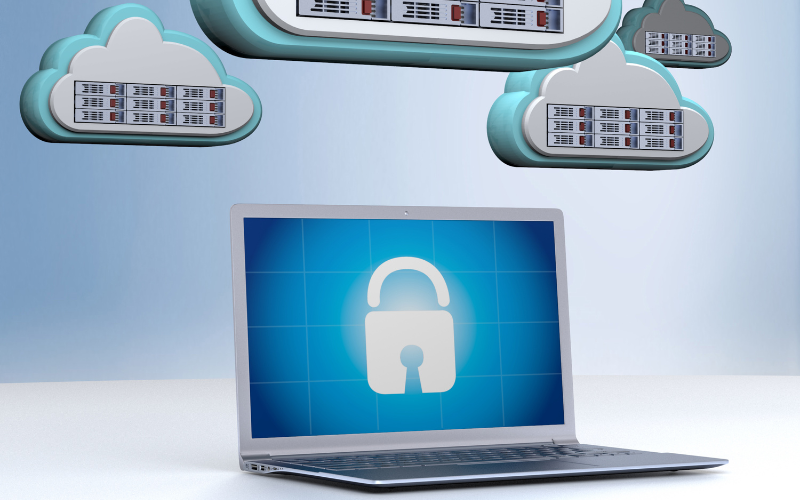Introduction
As more and more data is being stored in the cloud, the need for secure data storage and transmission has become increasingly important. One of the most common methods for achieving this is through encryption, which involves encoding data in such a way that it can only be accessed by authorized parties. However, there are two distinct states of encrypted data in secure cloud environments, and understanding the fundamental concepts behind these states is essential for ensuring the security of sensitive information. This paper will explore these two states of encrypted data and provide a comprehensive overview of their key features and differences.
Understanding Encryption In Secure Cloud

Encryption is a crucial component of secure cloud environments, as it helps protect sensitive data from unauthorized access. When data is encrypted, it is transformed into a code that can only be accessed by authorized parties who have the necessary decryption keys. In secure cloud environments, there are two distinct states of encrypted data: data at rest and data in transit. Data at rest refers to data that is stored in a cloud environment, such as on a server or in a database. In this state, the data is encrypted and stored in an encrypted format, which helps prevent unauthorized access. The encryption keys are typically managed by the cloud provider, who is responsible for ensuring that the data is secure and protected from potential threats.
Data in transit, on the other hand, refers to data that is being transmitted between different locations or devices. This could include data that is being sent between a user’s device and a cloud server, or between different cloud servers. In this state, the data is also encrypted to prevent unauthorized access. However, the encryption keys are typically managed by the user or organization that is transmitting the data, rather than the cloud provider.
There are several key differences between data at rest and data in transit encryption. For example, data at rest encryption is typically more secure because the data is not actively being transmitted or accessed. This means that the encryption keys can be stored in a more secure location, such as a hardware security module (HSM), and the data can be encrypted using stronger, more complex algorithms. On the other hand, data in transit encryption is necessary to protect data as it moves between different locations or devices. This type of encryption is typically implemented using secure protocols, such as SSL/TLS, and can be combined with other security measures such as firewalls and intrusion detection systems.
Ultimately, both data at rest and data in transit encryption are important components of a comprehensive data security strategy. By implementing both types of encryption, organizations can help ensure that their data is protected both when it is stored and when it is being transmitted.
States Of Encrypted Data In Secure Cloud

When data is stored in a secure cloud environment, it can be in one of three states: at rest, in transit, or in use. At rest refers to data that is stored on a cloud provider’s servers, but not actively being accessed or transmitted. In transit refers to data that is being transmitted between devices or networks, such as when a user accesses a cloud application from their computer or mobile device. In use refers to data that is actively being accessed or processed by an application or user. To ensure the security of data in these different states, various encryption techniques can be used. For data at rest, the cloud provider may use disk encryption to encrypt the data stored on their servers. This helps protect against unauthorized access if a server is compromised.
For data in transit, the cloud provider may use SSL/TLS encryption to encrypt the data as it is transmitted between the user’s device and the cloud application. This helps protect against interception and eavesdropping by unauthorized parties.
Finally, for data in use, the cloud provider may use techniques such as homomorphic encryption or secure enclaves to allow applications to process data without exposing it to potential attackers. These techniques help ensure that even if an attacker gains access to the application
Challenges In Securing Encrypted Data In Secure Cloud
Securing encrypted data in a secure cloud environment presents several challenges. One of the main challenges is ensuring the security of the encryption keys used to encrypt and decrypt the data. If the encryption keys are compromised, then the encrypted data can be easily accessed by unauthorized parties. Another challenge is ensuring the integrity of the data. While encryption can protect against interception and eavesdropping, it does not protect against data tampering. Therefore, it is important to implement measures such as digital signatures and hash functions to ensure the integrity of the data.
Furthermore, managing access to encrypted data can be challenging. Cloud providers need to ensure that only authorized parties have access to the data, while also ensuring that the data is available to authorized users when needed. This requires implementing robust access control mechanisms and monitoring access logs to detect any unauthorized access attempts.
Finally, implementing homomorphic encryption or secure enclaves can be complex and resource-intensive. These techniques require specialized hardware and software, and may not be practical for all cloud applications. Therefore, cloud providers need to carefully evaluate the risks and benefits of using these techniques before implementing them.
Future Of Encrypted Data In Secure Cloud

The future of encrypted data in secure cloud environments is promising. As more organizations move their data to the cloud, the need for secure and private data storage becomes increasingly important. Encrypted data provides an additional layer of security to protect sensitive information from unauthorized access and data breaches. Cloud providers are continuously improving their security measures to provide better protection for their customers’ data. This includes implementing advanced encryption techniques, such as homomorphic encryption or secure enclaves, to provide a higher level of security.
In addition, the development of quantum-resistant encryption algorithms is also a promising area of research. These algorithms are designed to withstand attacks from quantum computers, which could potentially break current encryption methods.
Overall, the future of encrypted data in secure cloud environments looks bright. As technology advances and security measures continue to improve, organizations can feel more confident in their ability to protect their sensitive data in the cloud.
Conclusion
The article discusses the importance of encryption in secure cloud environments and the challenges that come with it. It highlights the need for stronger encryption methods to protect sensitive data from cyber threats. The article also mentions the potential of quantum-resistant encryption algorithms to withstand attacks from quantum computers. Overall, the future of encrypted data in secure cloud environments looks promising with the advancement of technology and improved security measures.
The article discusses the importance of encryption in secure cloud environments and the challenges associated with it. It emphasizes the need for stronger encryption methods to protect sensitive data from cyber threats. The article also mentions the potential of quantum-resistant encryption algorithms to withstand attacks from quantum computers. Overall, the article suggests that the future of encrypted data in secure cloud environments looks promising with the advancement of technology and improved security measures.
Frequently Asked Questions (FAQs)
What Is The Difference Between Encrypted And Unencrypted Data In A Cloud?
Encrypted data in a cloud environment is data that has been transformed into a code that is unreadable without the proper decryption key. This is done to protect the data from unauthorized access or cyber threats. Unencrypted data, on the other hand, is data that is stored in its original, readable form and is more vulnerable to security breaches.
What Are The Benefits Of Encrypting Data In A Cloud?
Encrypting data in a cloud environment provides several benefits, including:
- Enhanced security: Encrypted data is more secure as it cannot be read or accessed without the proper decryption key. This reduces the risk of data breaches and cyber-attacks.
- Compliance with regulations: Many industries and countries have regulations that require sensitive data to be encrypted. Encrypting data in a cloud environment ensures compliance with these regulations.
- Protection against data loss: Encrypted data is less likely to be lost or corrupted during transmission or storage, as the encryption process adds an extra layer of protection against data loss.
- Increased privacy: Encryption ensures that only authorized individuals can access sensitive data, providing an increased level of privacy.
- Improved trust: Encrypting data can improve trust between customers and businesses, as it shows a commitment to protecting sensitive information.
- Better reputation: By implementing encryption, businesses can establish a reputation for being trustworthy and responsible when it comes to protecting sensitive data.
- Cost-effective: Implementing encryption can be cost-effective in the long run, as it reduces the risk of data breaches and the associated costs of remediation and damage control.
How Can I Ensure That My Data Is Properly Encrypted In A Cloud?
There are several steps you can take to ensure that your data is properly encrypted in a cloud environment:
- Choose a reputable cloud provider that offers encryption options and has a strong track record of security.
- Use strong encryption algorithms and keys to protect your data. Avoid using weak passwords or default encryption settings.
- Implement multi-factor authentication to prevent unauthorized access to your data.
- Monitor your cloud environment for suspicious activity or unauthorized access attempts.
- Limit access to your data to only those who need it, and implement strict access controls to prevent unauthorized access.
- Regularly review and update your encryption policies and practices to ensure they remain effective and current.
Can Encrypted Data Be Hacked Or Stolen?
While it is not impossible to hack or steal encrypted data, it is much more difficult than accessing unencrypted data. Encrypted data is transformed into a code that can only be deciphered with the correct decryption key. However, if the encryption key is weak or compromised, it can make the encrypted data vulnerable to hacking or theft. It’s important to regularly review and update your encryption policies and practices to ensure that they remain effective and up-to-date. Additionally, implementing other security measures, such as multi-factor authentication and regular monitoring for suspicious activity, can further protect your encrypted data.
What Should I Do If My Encrypted Data Is Lost Or Stolen?
If your encrypted data is lost or stolen, it’s important to take immediate action to protect your sensitive information. First, you should report the incident to your IT department or security team so they can investigate and take necessary steps to prevent further damage. You may also need to notify any affected parties, such as customers or clients, and provide them with information on how to protect their data. Depending on the severity of the incident, you may need to involve law enforcement or regulatory agencies. It’s also a good idea to review your encryption policies and practices to identify any potential weaknesses or areas for improvement.
How Does Encryption Affect Cloud Performance?
Encryption can have an impact on cloud performance, as it requires additional processing power to encrypt and decrypt data. This can result in slower data transfer speeds and longer processing times, which can affect the overall performance of cloud services. However, many cloud providers have implemented optimization techniques to mitigate the impact of encryption on performance. For example, some providers use hardware-based encryption to minimize the processing overhead, while others use advanced encryption algorithms that are optimized for performance. It’s important to strike a balance between security and performance when implementing encryption in the cloud and choose encryption methods appropriate for your specific needs.
Can I Access My Encrypted Data Anytime, Anywhere?
Accessing encrypted data in the cloud depends on the encryption method used and the access controls put in place. Generally, you will need to have the appropriate encryption keys to access the data, which means that you will need to authenticate yourself and have the necessary permissions to access the data. This can be done through a secure login process or the use of other authentication methods, such as biometric authentication. Additionally, some cloud providers may offer remote access to encrypted data through secure channels such as VPNs. However, it’s important to note that accessing encrypted data in the cloud may require additional security measures to ensure that the data is not compromised during transmission.
